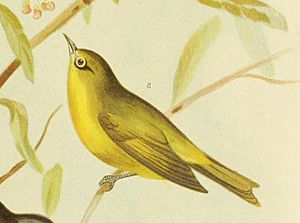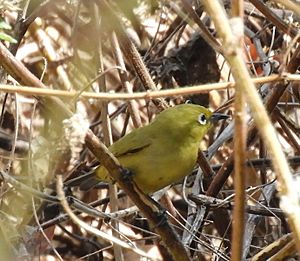Canary white-eye facts for kids
Quick facts for kids Canary white-eye |
|
|---|---|
 |
|
| Conservation status | |
| Scientific classification | |
| Genus: |
Zosterops
|
| Species: |
luteus
|
The canary white-eye or yellow white-eye (Zosterops luteus) is a small bird. It lives only in northern Australia. You can find it in warm, wet mangrove forests. Its common name comes from the circle of white feathers around its eye.
What it Looks Like
The canary white-eye is a small bird. It has a bright olive-green back. Its belly and the area around its eyes are yellow. A special feature is the ring of shiny silver-white feathers around each eye. It also has a dark stripe near its eye.
This bird eats nectar, which is a sweet liquid from flowers. It has a short, sharp beak. Its tongue is like a brush, similar to honeyeater birds. This helps it collect nectar.
Canary white-eyes are about 10 to 11 centimeters (4-4.3 inches) long. Their wings spread about 5.2 to 5.9 centimeters (2-2.3 inches). Their beak is about 1.3 to 1.6 centimeters (0.5-0.6 inches) long. They usually weigh between 6.5 and 11 grams (0.2-0.4 ounces).
Bird Family and Names
The canary white-eye belongs to a bird family called Zosteropidae. These birds are known as white-eyes or silver-eyes. You can find them in Africa, Asia, Australia, and many islands.
The scientific name for this bird is Zosterops luteus. It was named by John Gould in 1843. There are two main groups, or subspecies, of this bird. They live in different parts of Australia.
- Z. l. balstoni is found along the coast of northwest Australia. This includes places like Shark Bay.
- Z. l. luteus lives along the northern coast of Australia. This goes from the Northern Kimberley area to western Cape York Peninsula. There is also a small group in eastern Queensland.
The name Zosterops comes from ancient Greek words. Zoster means a belt or girdle, and ops means eye. This refers to the white ring around the bird's eye. The second part of the name, luteus, is Latin. It means golden or saffron yellow. This describes the bird's color.
The subspecies balstoni was named after W.E. Balston. He gave bird samples to the British Museum.
In Australia, people often call this bird the yellow white-eye.
How it Lives
Canary white-eyes live in mangrove forests and near rivers. They eat insects, including their young forms called larvae. They find these insects on the leaves of small trees and bushes. Sometimes, they look for food on muddy mangrove flats.
These birds like to be with others. You will usually see them in pairs or small groups.
The canary white-eye is listed as "Least Concern" (LC) by the IUCN Red List. This means it is not currently in danger of disappearing.
See also
 In Spanish: Anteojito australiano para niños
In Spanish: Anteojito australiano para niños



